Abstract
This study focuses on the properties of reflection and absorption of light in the visible and near infrared range of acrylic dyes and related materials for coloring. The research aims to understand the use of acrylic dyes in fine arts and to simulate these dyes for printing purposes. Two groups of acrylic dyes were studied using spectroscopy to determine their light absorption properties in the visible (VIS) and near infrared (NIR) regions. The measurements were performed with forensic cameras equipped with 24 light filters in the range of 400–1000 nm. The results of the digital recordings were compared with video surveillance cameras that operate and record during the day and night. The same color had at least two formulations of dyes for print reproduction to simulate what the naked eye sees and to simulate light absorption in the NIR spectrum. The study aimed to gain a deeper understanding of the properties of acrylic paints and related materials, considering how they can be used in fine arts and how to simulate them in printing.
1. Introduction
Each dye has its own characteristic properties of light absorption and reflection in the visible (V) and near infrared (NIR) spectra. Accordingly, every artistic painting, in addition to the image intended for the naked eye, has its own characteristic NIR image. In flora and fauna, each type of matter has its own characteristic colors with its own properties in relation to light [1]. In nature, we find the same hues with completely different substance compositions [2]. In this article, we use the term “color”, which is specific to our eyes and refers only to the visible V portion of sunlight, described numerically from 400 to 760 nanometers [3]. The substance that carries the color is called dye, pigment, or colorant. In this article, we extend the study of the properties of dyes from the V spectrum to the NIR spectrum. The first part of the NIR spectrum, ranging up to 1000 nm, is called the “Z” region [4]. The “VZ” infrared is an abbreviation of “VIS” and “Z region” (NIR region). Significant differences in light absorption in the NIR spectrum are used in the development of a new type of painting art, and two different images are created on the same paper. Each color tone can be realized in at least two different material compositions, with two different appearances in the NIR spectrum [5]. The uniformity and diversity of the light reflection of the painted material is used by artists to express themselves in their own personal ways [6].
Artists gain new knowledge about the matter of dyes, as well as a new instrumental view of matter, and discover new processes and tools in the creation of visual art [7].
In this paper, we present the characterization of a painter’s canvas with standard paint colors whose wavelengths were measured before application to the canvas, where the response of each color in the visible and infrared spectra was studied. Targeted measurements were made with the aim of creating a double image, of which the hidden image is visible in the infrared spectrum [8].
The image in the infrared spectrum can be observed by IR detectors and other types of cameras that read the image at 1000 nanometers. The IR image is embedded in the image visible to the eyes. Today’s museums and galleries are equipped with surveillance and monitoring devices that enable the viewing of images in the infrared spectrum [9]. Research on infrared painting and pigments is focused on the restoration of artworks by old masters, as well as the restoration of contemporary artworks [10].
It has been shown that painting dyes have been characterized by a duality throughout history, although the old masters were not aware of it. The use of infrared reflectography to reveal “overpainting” in artworks is a particularly interesting area of research [11].
The results of creating and applying two dependent images in two spectral regions have the possibility of widespread application and implementation, excluding fine arts and design. By comparing individual applications and measurements, which we describe in detail in this paper, one can create a basis for new realizations [12]. This method is based on the color property whereby any hue in the visible spectrum can be achieved in an infinite number of ways, while colors can also be defined as situated outside the range of wavelengths perceivable to the human eye, which can become visible to humans through the use of infrared cameras, which we already use for viewing at night.
In printing practice, dyes for artistic painting are simulated with conventional dyes. Simulation is executed with printing dyes in dual spectra without the usage of additional colors [13] (Yuri V. Kuznetsov, Principles of Image Printing Technology, pp. 252–261). The equality of two dyes is determined with the “ΔE” algorithm [14], which covers only the visible V spectrum [3].
2. Dyes in V and Z Spectra
Each color, including oil paint, acrylic paint, tempera paint, ceramic paint, and watercolor paint, is accompanied by a numerical value of light absorption at 1000 nm. By mixing different paints, new shades are obtained, which have new Z values.
This article presents 12 acrylic dyes for artistic painting.
Figure 1 shows the acrylic dye mixtures prepared by the painter Nada Žiljak.
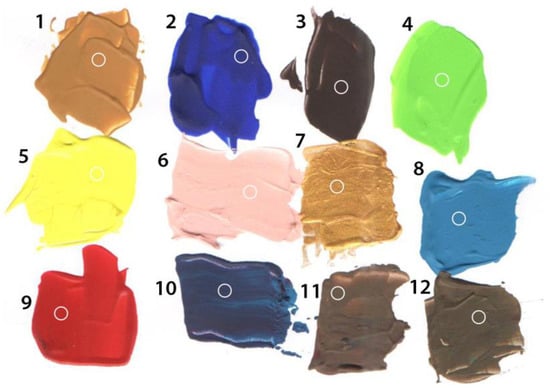
Figure 1.
RGB—visible spectrum, 12 acrylic dyes.
The individual components of the yellow, magenta, blue (cyan), and black colors are described in [4]. The visible range of the dyes is determined from 360 to 760 nm. As shown in Figure 2, these dyes were photographed with a filter at 735 nm [15]. The yellow and red color components have a range of up to 650 nm; thus, they do not react. As shown in Figure 2, only the blue color component retained the minimum values of the parameters *a and *b, which determine the state of the color [4].
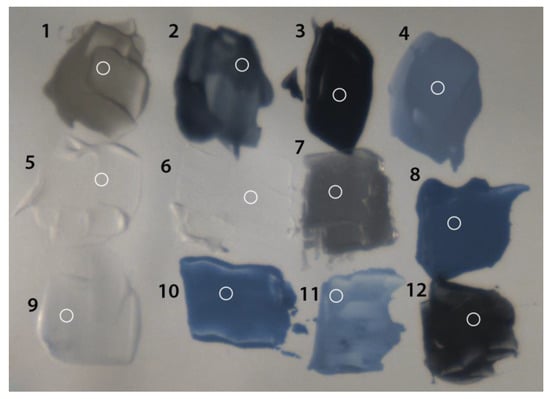
Figure 2.
Light blocking at 735 nm.
Figure 3 shows a photo depicting 850 nm blocking. There are no more positive values of *a and *b in this spectrum. The digital recording of dyes shows only their lightness, parameter L, as a gray tone. After recording the 12 selected colors in three blockades of lights, including the visible, 735 nm, and 850 nm, the L*a*b* value of each color was measured. Table 1 shows the approach for determining the a* and b* values in relation to the zero value as the recording wavelength increases. At 900 nm, these values reach zero, while only the L* lightness value remains, which is measured as a gray tone. The Z parameter in Table 1 shows us that at smaller wavelengths (750 nm), the Z values become smaller when they reach 900 nm. A comparison of dyes 7 and 8, shows the differences in light absorption in the NIR spectrum. At 750 nm, dye 7 has a value of 0.3, while dye 8 has a value of 0.5. Observing the infrared region at a wavelength of 900 nm more closely, we can see that dye 7 has a value of 0.08, and dye 8 has a value of 0.03. This proves that an apparently more saturated color in the visible part of the spectrum does not necessarily have to be saturated in the near infrared portion of the spectrum.
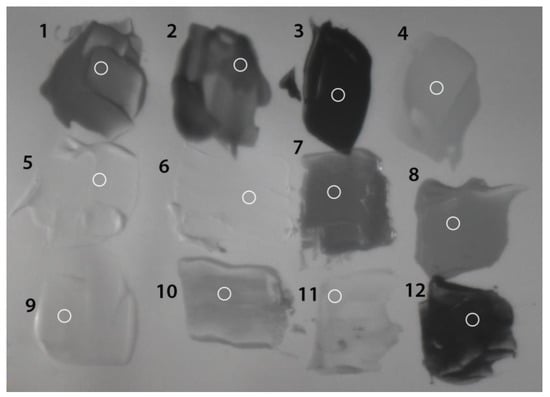
Figure 3.
Light blocking at 850 nm.

Table 1.
ACR11 dyes (1–12), λ max, Lab V, Lab 735, Lab 850, Z (735)750, Z 850, Z 900.
The second record (Figure 2) has blockade at 735 nm. It is the border between V and Z. The third record (Figure 3) is a Z record with blockade at 850 nm [2]. In this new, unique system of augmented reality, painters use the NIR camera to ensure that dyes are applied properly on the canvas. The same hue can be mixed in many different ways, with the same absorption properties for the visible part of the spectrum and different absorption properties for the near infrared wavelengths. These nuances are visible with the use of VZ dual cameras (ZRGB camera) [5], which remain unique on the market. Colors have unique responses in the visible and infrared wavelengths. Painters have a wide range of dyes available to them that cover the infrared range. Many dye mixtures used for the reproduction of artistic paintings without the infrared effect were analyzed with a “night shoot” camera. “Infrared painting” is the deliberate creation of separate graphics and images for observation with a NIR camera [15].
3. Spectroscopy of Dyes
Spectrographs for the dyes were obtained using the Projectina Docucenter 4500 Spectral Analysis System for Document Investigation from Projectina AG (Heerbrug, Switzerland), which operates in the range of 400 to 900 nm [15]. The dyes were determined using spectrographs for the visible and NIR spectra. The quantity Z was introduced to measure the absorption value of light at 1000 nm. For the measurements, the dye spectroscopy method was used in the range from 400 to 900 nanometers (shown in Figure 2). Figure 4, Figure 5 and Figure 6 show the spectroscopy of 12 dyes.
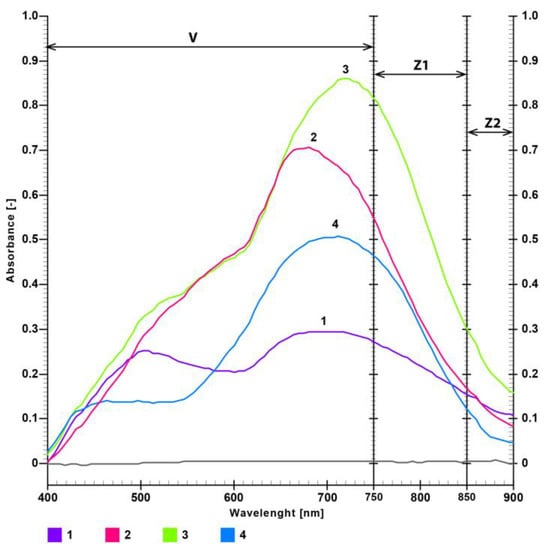
Figure 4.
Dyes 1, 2, 3, and 4 (first row in Figure 1).
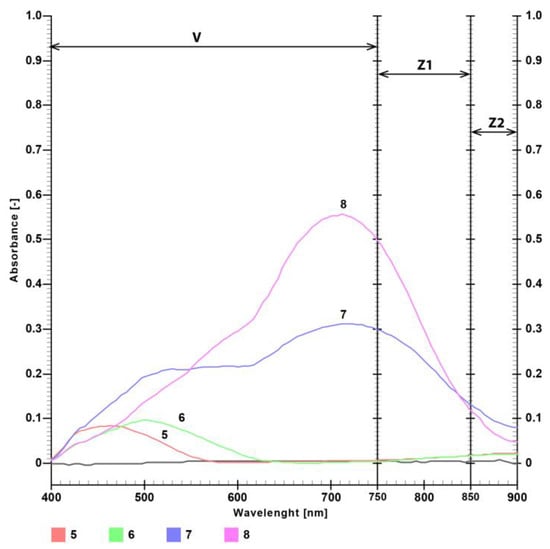
Figure 5.
Dyes 5, 6, 7, and 8 (second row in Figure 1).
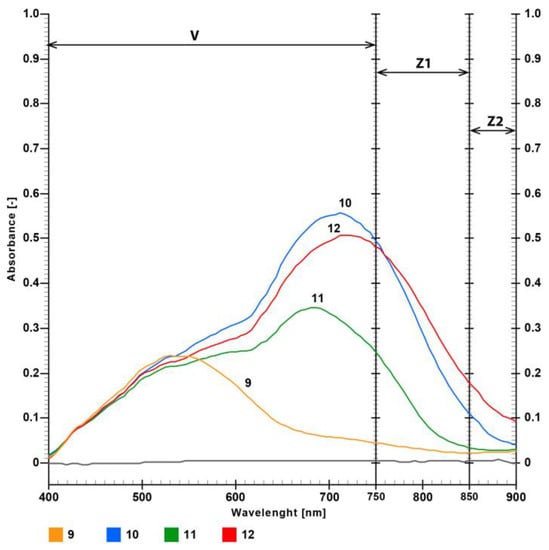
Figure 6.
Dyes 9, 10, 11, and 12 (third row in Figure 1).
Spectrographs are our main tool for determining the components of process dyes (C, M, Y, K). Spectra undoubtedly show the necessary directions of CMYK component repairs when we simulate colored materials derived either from nature or from an artistic painting or technical design in the context of security printing [1,2]. For each dye and for each component of its mixture, we determined the domain in the spectrum of light and the position of the absorption maximum. A graphical representation of each dye (1 to 12) is provided in Figure 4, Figure 5 and Figure 6. The light space is divided into three parts. Here, we introduce the Z1 and Z2 regions. The Z2 space is a region of light that shows only part of the NIR spectrum. This region provides us with information about how much color will appear independently on the Z camera. In simple terms, Z1 is a warning to the painter that the dye is still reflected in both the V and Z spectra. This region is the space for the separation of the twin dyes that will be used to simulate the painting material with the process dyes in print reproduction.
Some dyes, such as No. 5, No. 6, and No. 9, have narrow ranges. It is easier to programmatically adjust the process colors for them, specifically yellow and magenta, which initially have domains only in the visible spectrum [4].
4. Presentation of New Painting
“Infrared Art” is a combination of art and technology. In the field of painting, it is an innovative method of creating a unique image with a double appearance, one that is visible to the human eye in daylight and another that is only visible with the help of an infrared camera operating at NIR wavelengths. This new method of painting has also initiated research on the hues of standard paints and pigments used in artistic painting, which differ in their absorption properties for infrared light. In fact, this artform refers to the painting of two images in one continuous layer that contain different visual information in the visible and near infrared spectra. This is because each of the paints can be created in countless ways, with the same property of light absorption in the visible spectrum observable to the human eye and completely different properties in the near infrared spectrum. In this way, we can paint a double image on a single substrate. The artist does this by choosing different dyes with different light absorption properties in different spectral regions.
The painting method for creating artwork observed in the NIR spectrum is established, and the painter is given a new tool for painting in the “dark” to create “hidden” images (Figure 7). The result is a double painting, or two paintings that differ in content and artistic concept. The painter has video surveillance cameras with which he/she controls the dyes and the process of applying them to the canvas. The result is controlled during the actual painting in the visible and infrared spectra. When painting, the author also creates new mixtures of dyes that are subject to both the visible and infrared spectra.
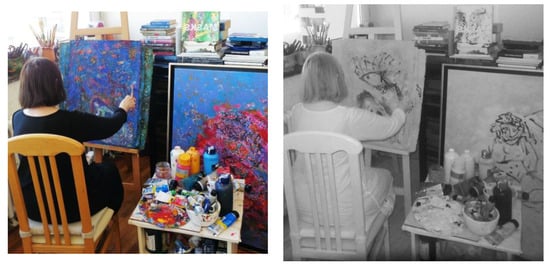
Figure 7.
Atelier in visible and NIR spectra (IRR—ZRGB cameras).
When painting, the dyes are applied in a thick layer on top of each other. The painter takes advantage of the dye’s transparency to develop a dual view of his work. Some dyes pass NIR light minimally, and some pass it completely.
In museums, artworks older than fifty years are recorded using the “InfraRed Reflectography” (IRR) process. This aims to prove the originality of the painting, especially in cases of forgery. The old masters marked their works and then repainted them with no intention that they would be seen in the future.
Today, fine artists create dual images for separate viewing in the visible and infrared spectra. There are two images on the canvas: one is visible with an infrared camera, and the other is visible to the naked eye. The two states of the image are photographed with a visual RGB camera and with an IR reflectography camera with a light filter at 1000 nm.
Academic painters show their familiarity with controlling color in the visible and near infrared spectra. They paint images in two wavelength ranges, VIS and NIR, using an “IR money detector” camera (a camera for visualizing banknotes in the NIR).
The order of dye application is based on the terms “upper and lower image”. Dyes are divided into those that absorb the NIR light spectrum and those that do not. Here, we are concerned with dyes with positive Z values in cases when we want to find something “below”. This is because many dyes have no Z value and cannot be seen with a Z camera, regardless of when and where they were photographed, even if they are situated at the very top, marking the end of the work accomplished during the painting. This is where the procedure, that is, the new method of painting, begins.
The Sveti Ivan Zelina Gallery hosts exhibitions of painters united under the name “INFRA GRUPA”/“INFRA GROUP” (Figure 8 and Figure 9). Their works are created through the technique of duality. They often employ and improve the procedures of applying dyes in multiple layers to achieve a separate state of two paintings. The exhibition catalog is accompanied by a critique by the art historian Sanda Stanaćev Bajzek [5]. Each painter individually mixes the dyes in his/her own way. In this way, the formulation of the dyes is expanded with the strict aim of achieving a group of dyes for the visual observation of the paintings and the instrumental observation of the paintings in the NIR spectrum.
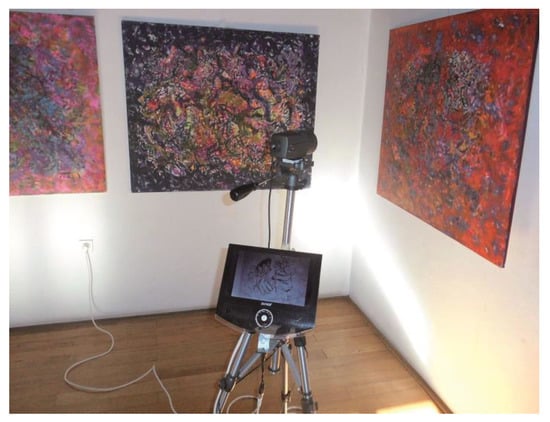
Figure 8.
Sveti Ivan Zelina Gallery, acrylic on canvas by the painter Nada Žiljak. View of the exhibition in the V spectrum.
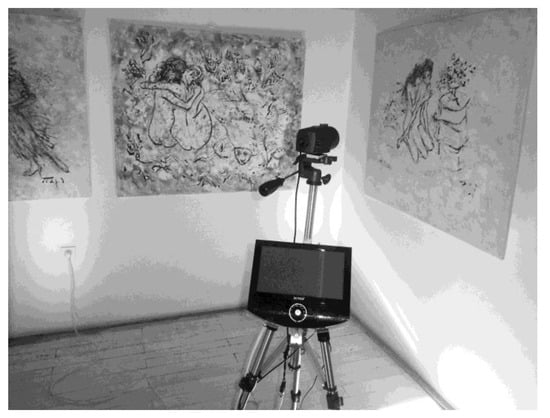
Figure 9.
Sveti Ivan Zelina Gallery, acrylic on canvas by the painter Nada Žiljak. View of the exhibition in the NIR-Z spectrum.
Painters consider, “which dye to use at the moment; is it V or Z?”, with the intention that the Z image will also appear on the canvas, either independent of the V image or dependent on the V image. Together, they create a new fine art. The Z image is viewed with a NIR camera that enables the Z record to be visible. That camera does not register the V image, but separates the Z image.
A numerical Z value is assigned to dyes for artistic painting, which represents the absorption power (information) in the infrared spectrum at a wavelength of 1000 nm. From here, expanded meanings and concepts are introduced in new ways: hiding, intimate painting, invisible images, and hidden information on the canvas.
5. Materials for the Dual Reproduction of VZ Painting
The image realized in two spectral regions is recorded with two cameras. One is a real camera that captures images in the visible spectrum. For example, in this work, we used the Nikon Z9. The image that we observe in the infrared spectrum is taken with a camera that has a filter and can view the IR spectrum, or with a surveillance camera such as those that surround us in urban areas today. To reproduce such a painted image, two V and Z photos are combined in a preparation process for prepress offset printing, in which offset transparent colors and coated “kunstdruck” paper are used. After printing, we obtain an image on the coated paper that is normally observed in the visible spectrum but can also be observed with infrared cameras.
The printed image has two states, just like the original painting of the author. The reproduction of the original printed image has the authentic properties of a double image and a certain degree of originality. There are some limitations, because painters use many different types of paints that have different properties. The CMYK process colors are limited by their own gamut. Because of this limitation, it is not possible to recreate all the colors as our eyes see them. This gamut expands increasingly with the inclusion of a Z area. Printing with the VZ method, the image cannot be photocopied or scanned. In such a case, the image in the infrared spectrum would be lost, because photocopiers and scanners cannot detect the infrared image, but only reproduce the image in the visible spectrum. This opens up a new area of originality for reproductions in catalogs and monographs of artworks.
Color models such as RGB, CMYK, HSB, and Lab are used when preparing graphics for printing. They refer to the visible part of the spectrum. The percentage of black color (K), determined by the GCR method, replaces certain CMY values and covers the entire color spectrum for printing. In the UCR method, black is added only to the CMY equivalent of what would be printed as gray: Gray Component Reduction or Gray Component Replacement, Under Color Removal [14] (Helmuth Kipphan Handbook of Print Media, p. 88).
C, M, and Y dyes absorb light only in the visible (V) range of the human eye [4]. A mixture of dyes C, M, and Y in equal parts is a black color, but this dye (called S) absorbs light only in the visible V spectrum. The black printing dye K (carbon black) absorbs light in the near infrared spectrum (Z). The black dyes S and K have different properties [4]. The black shade is achieved as a duality when we observe its light absorption properties in the NIR-Z spectrum. The mixture of dyes S and K is based on the theories of GCR and UCR. Here, we provide a new separation of dyes, whose algorithm we call VZ. We assign a new meaning to the GCR/UCR method, a new application with the aim of realizing dual graphics. This method is concerned not only with saving dyes but also with deliberately situating the controlled appearance of the images in the NIR-Z spectrum.
The numerical values of the twin dyes illustrate trends in future printing practices. Two versions of the same color with different amounts of C, M, Y, and K are “read” by the Z camera in the NIR spectrum (Figure 10). Table 2 shows the extreme values of the twin dyes. The first, the left twin (circular shape), with A1, A5, G1, and S5, has no carbon black dye. The second (right twin) has a black dye coverage of 40 percent. The selected colors, A2, A6, G2, and S6, are the GCR transformation with the maximum amount of black color. In such a separation, at least one of the C, M, or Y components of the dye is at its minimum, or its value is zero [14].
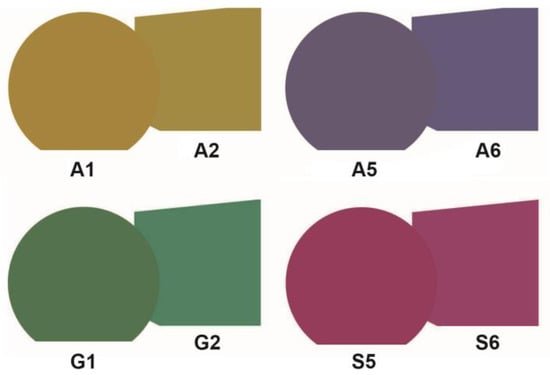
Figure 10.
Four pairs of twin colors and dyes with K = 40%.

Table 2.
Formulations for the colors and dyes of four twin pairs.
The parallel mixing of dyes from the printing assortment creates new series of dye twins. When mixing printing dyes, one must follow the formulations for process dyes while controlling the weight values of the painting dyes. The matching of the dye twins is achieved by spectroscopy. Painting colors with the same tones and different Z values are projected. This means that the current composition of Z values in the artwork will be examined and then used in the composition of the twins for the print reproduction stage. Twins can be achieved in countless ways and are also a simulation of dyes derived individually “from the hand” of the artist.
Twin dye graphs have equal graph lines in the spectral range from 400 to 700 nm (Figure 11). Their divergence is an indication to the programmer (his/her separation algorithm) that he/she must perform a dye separation repair. By measuring the twin dyes, we can calculate the ΔE so as to determine the distance between the two colors in the color space and to quantify the visual difference between them. The distance between the two colors E1 and E2 in the CIELab color space is calculated using the formula below [14]:
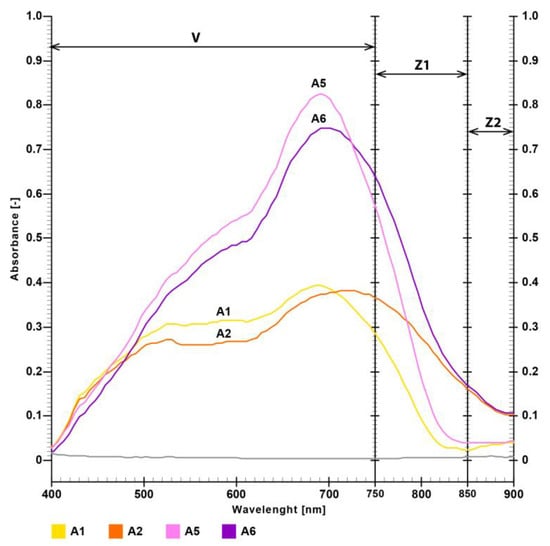
Figure 11.
Comparison of the spectrographs for the Drab and Blue process twin dyes.
With the new values obtained from the measurements, a new separation is created, and the new test prints are created. The test prints are measured again, and the ΔE is checked until the desired minimal color difference between the twins is achieved. The twins have a minimal difference in VIS but meet the specified values of light absorption in the NIR spectrum (Figure 12).
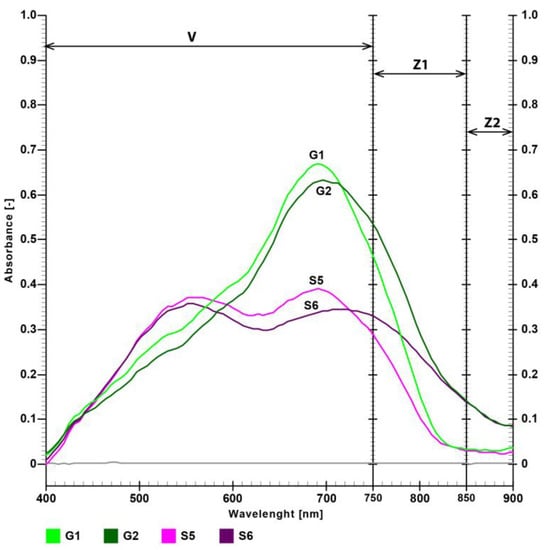
Figure 12.
Comparison of the spectrographs for the Green and Dark Red process twin dyes.
To obtain the appropriate quality of dye twins and colors for VZ reproduction, we performed an analysis of 12 twins (Table 1) to derive parameters for the relationship using the regression method [1]. The interdependence of the dye formulations between the visible and NIR spectra was determined.
The painter determines the dye mixtures by observing and photographing them with dual ZRGB cameras in the VIS and NIR spectra [1]. From these photographs, the painter can document the process of mixing the colors of the dye twins and the creation of the painting as one part of the digital specimen. It is also desirable for the painter to store the pairs of dye twins on a base (e.g., paper).
The application of dualism through V and Z is part of the new technology for reproducing monographic editions with conventional printing techniques [5,6]. Formulations for mixing dyes in the visible and infrared spectra have been developed in the printing industry with the aim of simulating a range of dyes applied in artistic painting (i.e., the green color in Table 1 and Figure 3).
The VZ separation and GCR/UCR methods perform their own tasks in printing reproduction, including the replacement of K with CMY as a reduction in the total amount of dyes, contrast control, and other roles. VZ separation has a preset value of K as information obtained from Z images. The subtraction of C, M, and Y is subordinated to the color value of the RGB image and the Z value. In this procedure, a compromise is accepted in extreme cases, as it is impossible to completely satisfy the amount of K. In such cases, a reduced amount of K dye is used so that the reproduction provides the same visual experience.
6. Discussion and Conclusions
Infrared design can be applied in fine arts in a way that allows us to explore dimensions beyond the visible range of human sight. The application of infrared opens up new fields, presenting artwork with a hidden picture that the viewer can discover by extending his/her sight with the help of a near infrared camera.
The substance that carries the dyes is mixed with the intention of expanding the painting into the infrared spectrum. Here, a procedure for creating a dual artwork was proposed and developed to digitally archive the entire process as a specimen. The spectrographs of painting dyes presented in this study provide crucial parameters for determining twin dyes, enabling the simulation of dye reproduction. The original painting is based on dyes with distinct characteristics in both the visible and infrared spectra. These twin dyes are applied in multiple layers to the same location, rendering the artwork difficult to forge.
We proposed a new simulation method for dyes used in artworks with CMYK process colorants through the development of a technique for combining two images, a visual RGB image and a NIR-Z image, into a common image for preparing reproductions during CMYK printing. The separation based on the VZ procedure was presented as a new version of the GCR/UCR technique for conventional printing. The results of the experiments with the dyes were verified with a new print iteration and the corresponding spectroscopy results to determine the twin dyes.
The use of infrared technology in restoration is recommended for the artworks of both old masters and new artists who intentionally create dual-spectrum paintings.
In the case of fine art monographs, we propose printing two separate images: one showing the artwork as seen by the naked eye in the visible spectrum, and a second image showing the painting as captured by a NIR camera. Additionally, images captured by blocking at 735 nm and 850 nm can be included to provide a more detailed representation of the dual-spectrum artwork.
Author Contributions
Conceptualization: J.Ž.G. and S.P.; methodology: J.Ž.G. and S.P.; software: S.P. and J.Ž.G.; validation: T.B. and I.Ž.S.; formal analysis: I.Ž.S. investigation: J.Ž.G. and S.P.; resources: J.Ž.G. and I.Ž.S.; data curation: J.Ž.G. and T.B.; writing—original draft preparation: J.Ž.G.; writing—review and editing: I.Ž.S. and S.P.; visualization: T.B. and S.P.; supervision: I.Ž.S. All authors have read and agreed to the published version of the manuscript.
Funding
This research received no external funding.
Institutional Review Board Statement
Not applicable.
Informed Consent Statement
Not applicable.
Data Availability Statement
Data are contained within the article.
Conflicts of Interest
The authors declare no conflict of interest.
References
- Gršić, J.Ž.; Jurečić, D.; Golubić, L.T.; Žiljak, V. Hidden Information in Uniform Design for Visual and Near-Infrared Spectrum and for Inkjet Printing of Clothing on Canvas to Enhance Urban Security. Appl. Sci. 2022, 12, 2152. [Google Scholar] [CrossRef]
- Gršić, J.Ž.; Jurečić, D.; Golubić, L.T.; Plehati, S. Security Graphics with Multilayered Elements in the Near-Infrared and Visible Spectrum. Information 2022, 13, 47. [Google Scholar] [CrossRef]
- Lv, G.-W.; Cao, P.; Huang, Y. Maximum Dynamic Range of GCR Based on Metamerism and Application. Int. J. Sci. Technol. Res. 2021, 10, 152–158. [Google Scholar]
- Gršić, J.Ž. Near infrared spectroscopy in print technology. Polytech. Des. 2017, 5, 32–36. [Google Scholar] [CrossRef]
- Pogarčić, I.; Agić, A.; Matas, M. Evaluation of the Colorant Twins for the Neutral Grey Spectra in Infrared Graphic Procedure. Tech. Gaz. 2016, 6, 1659–1664. [Google Scholar]
- Čorda, D.N.; Gršić, J.Ž. Extended Method of Restoration Retouching in The Near-Infrared Spectrum. In Proceedings of the 8th SWS International Scientific Conference on Social Sciences—ISCSS 2021, Vienna, Austria, 8–11 December 2021; pp. 667–680. [Google Scholar] [CrossRef]
- Jurečić, D.; Gršić, J.Ž.; Bratić, D.; Plehati, S. Separating Information on Transparent Polypropylene Labels on Packaging with Dual Properties for the Visible Spectrum and Instrumental Infrared Observation. Polymers 2022, 14, 5341. [Google Scholar] [CrossRef] [PubMed]
- Gršić, J.Ž.; Filipović, K.G.; Jurečić, D.; Žiljak, V. INFRAREDESIGN® as a Way of Individualizing and Protecting the Textile and High Fashion Design. Eur. J. Appl. Sci. 2021, 9, 110–117. [Google Scholar] [CrossRef]
- Li, C.; Wang, C.; Wang, S.J. A Black Generation Method for Black Ink Hiding Infrared Security Image. In Applied Mechanics and Materials; Trans Tech Publications: Dürnten-Zürich, Switzerland, 2013; Volume 262, pp. 9–12. [Google Scholar] [CrossRef]
- Čorda, D.N. Art Picture from Museums, Collections and Temporary Exhibitions of Crosslinking in Near Infrared Spectrum. Polytech. Des. 2018, 6, 166–170. [Google Scholar]
- Nazor, D. Finding Hidden Information in the Infrared Spectrum in Paintings in the Carmelite Monastery in Remete and a Private Collection in Zagreb. Polytech. Des. 2014, 2, 153–162. [Google Scholar] [CrossRef]
- Friščić, M.; Agić, A.; Stanimirović, I.Ž. Visual and infrared graphic applied through dedicated halftoning for transparent polypropylene packaging. Tech. Gaz. 2017, 24, 225–230. [Google Scholar] [CrossRef]
- Kuznetsov, Y.V. Principles of Image Printing Technology; Springer: Cham, Switzerland, 2021; pp. 252–261. [Google Scholar] [CrossRef]
- Kipphan, H. Handbook of Print Media; Springer: Berlin/Heidelberg, Germany, 2001; ISBN 3-540-67326-1. [Google Scholar]
- Projectina Docucenter 4500, SP-2000 Color Spectroscopy Module & PAG B50 Custom Designed with 24 Barrier Filters, Projectina AG, Dammstrasse 2, P.O. Box CH-9435 Heerbrugg, Switzerland. Available online: https://www.projectina.ch/products/document-examination/spectra-pro/ (accessed on 19 December 2022).
Disclaimer/Publisher’s Note: The statements, opinions and data contained in all publications are solely those of the individual author(s) and contributor(s) and not of MDPI and/or the editor(s). MDPI and/or the editor(s) disclaim responsibility for any injury to people or property resulting from any ideas, methods, instructions or products referred to in the content. |
© 2023 by the authors. Licensee MDPI, Basel, Switzerland. This article is an open access article distributed under the terms and conditions of the Creative Commons Attribution (CC BY) license (https://creativecommons.org/licenses/by/4.0/).